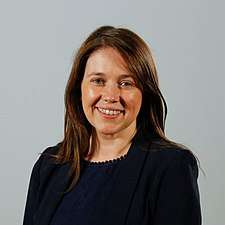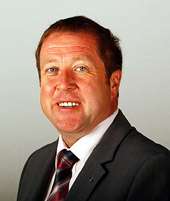Scottish Government
The Scottish Government (Scottish Gaelic: Riaghaltas na h-Alba) is the devolved government of Scotland.[2]
| Scottish Government | |
|---|---|
| Scottish Gaelic: Riaghaltas na h-Alba Scots: Scots Govrenment | |
| Overview | |
| Established | 1 July 1999 |
| Country | Scotland |
| Leader | First Minister |
| Appointed by | First minister approved by Parliament, ceremonially appointed by the monarch |
| Main organ | Scottish Cabinet |
| Responsible to | Scottish Parliament |
| Annual budget | GB£40.3 billion (2018/19)[1] |
| Headquarters | St Andrew's House, Calton Hill, Edinburgh |
| Website | gov |
The government is led by the first minister, who selects the cabinet secretaries, who attend cabinet, and ministers with the approval of parliament.[3][4] Government ministers all sit in parliament, and are accountable to it. The government is dependent on parliament to pass primary legislation.
The government was established in 1999 as the Scottish Executive under the Scotland Act 1998, which created a devolved administration of Scotland in line with the result of the 1997 referendum on Scottish devolution.[5] Following increasing use of the name "government" in place of "executive" during the first decade of the 21st century, its name was formally changed in law to Scottish Government by the Scotland Act 2012.
Responsibilities
The Scottish Government has power over so-called devolved matters, which are matters not reserved to the United Kingdom Parliament by Schedule 5 to the Scotland Act 1998, as amended by subsequent revisions to the devolution settlement in the Scotland Act 2012 and Scotland Act 2016.
The original set of devolved matters under the Scotland Act 1998 included:[6]
- Healthcare
- Education
- Justice
- Most aspects of transport
- Environment
- Policing
- Rural Affairs
- Housing
Subsequently, the Scotland Acts of 2012 and 2016 transferred powers over:[7]
- Some taxation powers – Full control of Income Tax on income earned through employment, Land and Buildings Transaction Tax, Landfill Tax
- Drink driving limits
- Scottish Parliament & local authority elections
- Some social Security powers
- Crown Estate of Scotland
The most prominent reserved matters that remain under the control of the United Kingdom Government and Parliament are:[8]
- Immigration & Nationality
- The Constitution – Acts of Union, The Crown, Devolution Settlement
- Foreign Policy
- National Security and Defence
- Economic policy
- Trade and industry
- Energy
- Most aspects of Social Security
- Civil Service
- Consumer rights
- International Development
- Copyright
- Telecommunications & Postal services
- Broadcasting
- Reserved taxes
- Currency
- Pensions
The members of the government have substantial influence over legislation in Scotland, putting forward the majority of bills that are successful in becoming Acts of the Scottish Parliament.[9]
Cabinet Secretaries, Junior Ministers & Law Officers
The government is led by the first minister. The Scottish Parliament nominates one of its members to be appointed as first minister by the head of state.[10] He or she is assisted by various Cabinet secretaries with individual portfolios, who are appointed by the first minister with the approval of Parliament. Junior ministers are similarly appointed to assist Cabinet secretaries in their work. The Scottish law officers, the lord advocate and solicitor general, can be appointed without being a member of the Scottish Parliament, however, they are subject to Parliament's approval and scrutiny. Law officers are also appointed by the head of state on the recommendation of the first minister.[10] The first minister, Cabinet secretaries, junior ministers and the law officers are known collectively as the "Scottish Ministers". The Scottish Government uses a government structure that has a dual executive structure of a Cabinet that invokes collective decision-making, as well as non-cabinet members as junior ministers. A Cabinet secretary is a member of the Government who partakes in Cabinet, whereas junior ministers assist Cabinet secretaries but are not part of the Scottish Cabinet. The Cabinet secretaries and junior ministers are:[11][12][13]

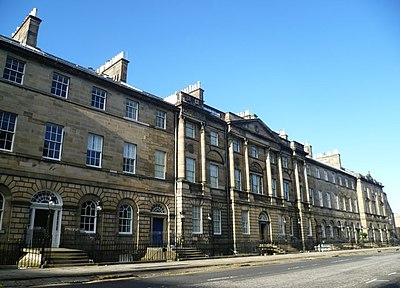

| Law Officers | |
|---|---|
| Portfolio | Minister |
| Lord Advocate | The Rt Hon James Wolffe QC |
| Solicitor General for Scotland | Alison Di Rollo QC |
Cabinet
| Second Sturgeon government | |
|---|---|
8th Government of Scotland | |
| 2016–present | |
 2018 Cabinet gathered outside Bute House, Edinburgh | |
| Date formed | 18 May 2016 |
| People and organisations | |
| Head of state | Elizabeth II |
| Head of government | Nicola Sturgeon MSP |
| Deputy head of government | John Swinney MSP |
| Total no. of members | 26 (including First Minister) |
| Member party | SNP |
| Status in legislature | Minority |
| Opposition parties | Scottish Conservatives Scottish Labour Scottish Greens Scottish Liberal Democrats |
| History | |
| Election(s) | 2016 |
| Legislature term(s) | 5th Scottish Parliament |
| Budget(s) | 2016 budget |
| Predecessor | First Sturgeon government |
The Scottish Cabinet is the group of ministers who are collectively responsible for all Scottish Government policy. While parliament is in session, the cabinet meets weekly.[15] Normally meetings are held on Tuesday afternoons in Bute House, the official residence of the first minister. The cabinet consists of the cabinet secretaries, excluding the Scottish law officers (the lord advocate and the solicitor general). The lord advocate attends meetings of the cabinet only when requested by the first minister, and he is not formally a member.[16]
The cabinet is supported by the Cabinet Secretariat, which is based at St Andrew's House.
Cabinet Sub-Committees
There are currently two sub-committees of Cabinet:[17]
- Cabinet Sub-Committee on Legislation
- Membership: the Deputy First Minister and Cabinet Secretary for Health and Wellbeing, the Minister for Parliamentary Business, and the Lord Advocate.
- Scottish Government Resilience Room (SGoRR) Cabinet Sub-Committee
- Membership: Cabinet Secretary for Justice (Chair), the Cabinet Secretary for Finance and Sustainable Growth, the Cabinet Secretary for Health and Wellbeing, the Cabinet Secretary for Rural Affairs and the Environment and the Lord Advocate.
For several years prior to the Glasgow 2014 Commonwealth Games there had been a third sub-committee of Cabinet:
- Glasgow 2014 Legacy Plan Delivery Group
- Membership: Deputy First Minister and Cabinet Secretary for Health and Wellbeing (Chair), Minister for Community Safety, Minister for Culture, External Affairs and the Constitution, Minister for Enterprise, Energy and Tourism, Minister for Environment, Minister for Housing and Communities, Minister for Public Health and Sport, Minister for Schools and Skills, and the Minister for Transport, Infrastructure and Climate Change.
Civil Service
Scottish Government also includes a civil service that supports the Scottish ministers. According to 2012 reports, there are 16,000 civil servants working in core Scottish Government directorates and agencies.[18] The civil service is a matter reserved to the British parliament at Westminster (rather than devolved to Holyrood): Scottish Government civil servants work within the rules and customs of Her Majesty's Civil Service, but serve the devolved administration rather than British government.[19]
Permanent Secretary
The permanent secretary is the most senior Scottish civil servant, leads the strategic board, and supports the first minister and cabinet. The current permanent secretary is Leslie Evans, who assumed the post in July 2015.
The permanent secretary is a member of Her Majesty's Civil Service, and therefore takes part in the permanent secretaries management group of the Civil Service[20] and is answerable to the most senior civil servant in Britain, the Cabinet Secretary (not to be confused with Scottish Government cabinet secretaries), for his or her professional conduct. He or she remains, however, at the direction of the Scottish ministers.
Directorates
"Directorates" are the ministries of the Scottish Government. They serve to execute government policy. Unlike in the British government, cabinet secretaries, the equivalent of British government secretaries of state, do not lead the directorates, and have no direct role in their operation. Instead, the directorates are grouped together into six "Directorates General", each run by a senior civil servant who is titled a "Director-General". As of July 2017, there are six Directorates General:
- Constitution and External Affairs Directorates
- Economy Directorates
- Education, Communities and Justice Directorates
- Health and Social Care Directorates
- Organisational Development and Operations Directorates
- Scottish Exchequer Directorates
Supporting these directorates are a variety of other corporate service teams and professional groups.[21]
The Crown Office and Procurator Fiscal Service serves as an independent prosecution service in Scotland, and is a ministerial department of the Scottish Government. It is headed by the Lord Advocate, who is responsible for prosecution, along with the procurators fiscal, under Scots law.
Strategic Board
The strategic board is composed of the permanent secretary, the six directors-general, two chief advisers (scientific and economic) and four non-executive directors. The board is responsible for providing support to the government through the permanent secretary, and is the executive of the Scottish civil service.[22]
Executive Agencies
To deliver its work, there are 9 executive agencies established by ministers as part of government departments, or as departments in their own right, to carry out a discrete area of work. These include, for example, the Scottish Prison Service and Transport Scotland. Executive agencies are staffed by civil servants.
There are two non-ministerial departments that form part of the Scottish administration, and therefore the devolved administration, but answer directly to the Scottish Parliament rather than to ministers: these are the General Register Office for Scotland and the Office of the Scottish Charity Regulator.
Public Bodies
The Scottish Government is also responsible for a large number of non-departmental public bodies. These include executive NDPBs (e.g. Scottish Enterprise); advisory NDPBs (e.g. the Scottish Law Commission); tribunals (e.g. the Children's Panel and Additional Support Needs Tribunals for Scotland); and nationalised industries (e.g. Scottish Water). These are staffed by public servants, rather than civil servants.
The Scottish Government is also responsible for some other public bodies that are not classed as non-departmental public bodies, such as NHS Boards, Visiting Committees for Scottish Penal Establishments or HM Chief Inspector of Constabulary for Scotland.
Offices
The main building of the Scottish Government is St Andrew's House, which is located on Calton Hill in Edinburgh. Some other government departments are based at Victoria Quay in Leith, Saughton House on Broomhouse Drive, and Atlantic Quay on Broomielaw, Glasgow. The Crown Office and Procurator Fiscal Service has its head offices, and the Lord Advocate's Chambers, at Chambers Street in central Edinburgh.
There are numerous other Edinburgh properties occupied by the Scottish Government. The Security Branch is based in the old Governor's House on the site of the former Calton Gaol, next door to St Andrew's House on Regent Road. The Government Car Service for Scotland also has its Edinburgh offices on Bonnington Road, in Leith. Other offices are scattered around central Edinburgh, including Bute House on Charlotte Square, the official residence of the first minister.
New St Andrew's House, above and behind Edinburgh's St James' Centre, was once a large Scottish Office building, which was occupied from 1973 until 1997, when the last remaining staff moved to Victoria Quay.
The first minister has use of the Scotland Office building, Dover House in Whitehall when necessary.[23]
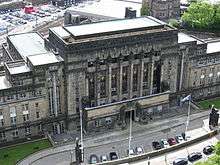
- Victoria Quay, Leith
- Entrance to Bute House
International offices
The Scottish Government has a European Union representative office, located at Rond-Point Robert Schuman in Brussels, Belgium, which forms a part of the United Kingdom Permanent Representation to the European Union.[24] The Scottish Government also maintains offices within the British Embassy in Washington, D.C., as well as the British Embassy in Berlin and has accredited representatives within the British Embassy in Beijing.
Name change
.png)
The original Scotland Act 1998 gave the name "Scottish Executive" as the legal term for the devolved government. In January 2001, the then First Minister Henry McLeish suggested changing the official name from "Scottish Executive" to "Scottish Government". The reaction from the British Government and from some Labour Party members and Scottish Labour MPs was allegedly hostile.[25] This reaction was in contrast to a 2001 public survey by then-Labour chief whip Tom McCabe, which showed that only 29% of the Scottish public wanted the title Scottish Executive to remain.[26]
Scottish politicians, including the Labour first minister, had often referred to the executive as the "government" and this trend increased following the 2007 election, when the SNP took office and Labour were in opposition for the first time. On 2 September 2007, the SNP minority government announced that the Scottish Executive was to be retitled as the "Scottish Government".
The renaming was decided unilaterally by the minority government; as a consequence, the SNP was criticised by the three Unionist opposition parties for acting without allowing for parliamentary scrutiny, debate or approval of their plan. However, the term "Scottish Government" has since then become common currency among all of the political parties in Scotland and the rest of the UK.[27] The official Gaelic title, Riaghaltas na h-Alba, has always meant "Government of Scotland".
"Scottish Executive" remained the legal name under section 44(1) of the Scotland Act 1998 until 2 July 2012. Neither the Scottish Government nor the Scottish Parliament were able to change the legal name, as this required the British Parliament to amend the Scotland Act. Section 12(1) of the Scotland Act 2012, which came into effect on 3 July 2012, formally changed the legal title to "Scottish Government".
At the same time that the Scottish Government began to use its new name, a new emblem was adopted. The earlier version featured the old name and a version of the Royal Arms for Scotland, but without the motto, the helm, the mantling, the crest, the war-cry above the crest, or the flags of Scotland and England carried by the supporters. In the rendering used, both supporters appeared to be crowned with the Crown of Scotland, whereas in the Royal Arms, the Scottish unicorn is usually shown crowned with the Scottish Crown, and the English lion with St Edward's Crown.
In the September 2007 re-branding, this depiction of the Royal Arms was replaced by one of the Flag of Scotland.[28] In 2016, a refreshed version of the Scottish Government logo was launched and used on all government websites and letters of correspondence as part of the national Gaelic Language Plan.
List of successive Scottish Governments
In the first two terms of the Scottish Parliament, the government was formed by a coalition of Labour and Liberal Democrats. In the three terms since the 2007 election, the Scottish National Party has held the largest number of seats and has formed a devolved government on its own. They formed the first majority government in 2011, lost the majority at the 2016 election, but remain as the largest party. The current first minister is Nicola Sturgeon, who is the first woman to hold the post, and has served since 19 November 2014.
See also
- Joint Ministerial Committee
- Local income tax
- Council of Economic Advisers (Scotland)
- Scottish Broadcasting Commission
- Scottish Social Attitudes Survey
- 2014 Scottish independence referendum
- Scotland Act 2016
- History of Scottish devolution
- Welsh Government
- United Kingdom withdrawal from the European Union
- Government spending in the United Kingdom
- Revenue Scotland
References
- "Budget (Scotland) Act 2018". The National Archives. Retrieved 31 August 2018.
- Jeffery, Charlie (2009). The Scottish Parliament 1999-2009: The First Decade. Luath Press. ISBN 1906817219.
- "The First Minister of Scotland". The Scottish Government. 8 March 2015. Retrieved 8 March 2015.
- "The Scottish Cabinet". The Scottish Government. 4 July 2012. Retrieved 23 October 2013.
- "Scotland Act 1998". The National Archives. Retrieved 23 November 2016.
- "What is Devolution?". Scottish Parliament. Retrieved 29 August 2018.
- "What the Scottish Government does". Scottish Government. Retrieved 8 August 2019.
- "Devolution settlement: Scotland". UK Government. Retrieved 29 August 2018.
- "How the Scottish Parliament Works". gov.scot. Archived from the original on 14 October 2013. Retrieved 23 October 2013.
- "Appointment and Role". firstminister.gov.scot. Office of the First Minister of Scotland. 5 February 2015. Retrieved 22 January 2016.
- "FM nominates his cabinet" (Press release). The Scottish Government. 16 May 2007. Retrieved 22 October 2013.
- "Changes to Scottish Government" (Press release). The Scottish Government. 10 February 2009. Retrieved 23 October 2013.
- "Keith Brown named new Scottish transport minister". BBC News. 12 December 2010. Retrieved 23 October 2013.
- "New Cabinet appointed". Scottish Government News. Retrieved 27 June 2018.
- "Guide to Collective Decision Making". Scottish Government. 12 November 2008. Retrieved 17 August 2014.
- "Lord Advocate excluded from new Cabinet". The Scotsman. 22 May 2007. Retrieved 23 October 2013.
- "Current Cabinet Sub-Committees". The Scottish Government. 13 December 2014. Retrieved 4 August 2014.
- Peterkin, Tom (5 June 2013). "Independent Scotland civil service '£700m a year'". The Scotsman. Retrieved 23 October 2013.
- "Answers to Frequently Asked Questions". The Scottish Government. 26 June 2012. Retrieved 23 October 2013.
- "Permanent Secretary". The Scottish Government. 1 May 2013. Retrieved 22 October 2013.
- "Directorates". The Scottish Government. 23 August 2013. Retrieved 23 October 2013.
- "Strategic Board". The Scottish Government. 29 May 2013. Retrieved 23 October 2013.
- "Dover House base for Scottish Secretary and Advocate General" (Press release). The Scottish Government. 8 March 1999. Retrieved 23 October 2013.
- "Scotland in the EU". The Scottish Government. 24 September 2012. Retrieved 23 October 2013.
- Britten, Nick (10 January 2001). "Fury at bid to rename Scottish Executive". The Daily Telegraph. Retrieved 23 October 2013.
Henry McLeish, the First Minister, threatened to set himself on a collision course with Tony Blair by wanting to rename the Executive the Scottish Government. The proposal caused an immediate split in Labour ranks and left McLeish facing allegations of arrogance and over-ambition. Scotland Office minister Brian Wilson said that the First Minister should think carefully about using the term "government". He said: "Maybe they should take time to look at how other countries with two tiers of government handle this. Nobody in Germany has any difficulty distinguishing between the government and the devolved administrations."
- "Scottish Executive renames itself". BBC News. 3 September 2007. Retrieved 23 October 2013.
- Scottish Parliament. Official Report. 25 February 2010 Archived 5 June 2011 at the Wayback Machine
- "Annual Report and Accounts: 2009–10" (PDF). Accountant in Bankruptcy. 4 August 2010. p. 61. Retrieved 23 October 2013.
.png)
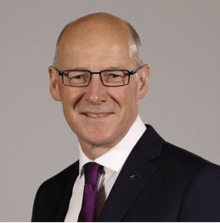


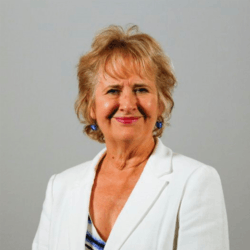

.jpg)
